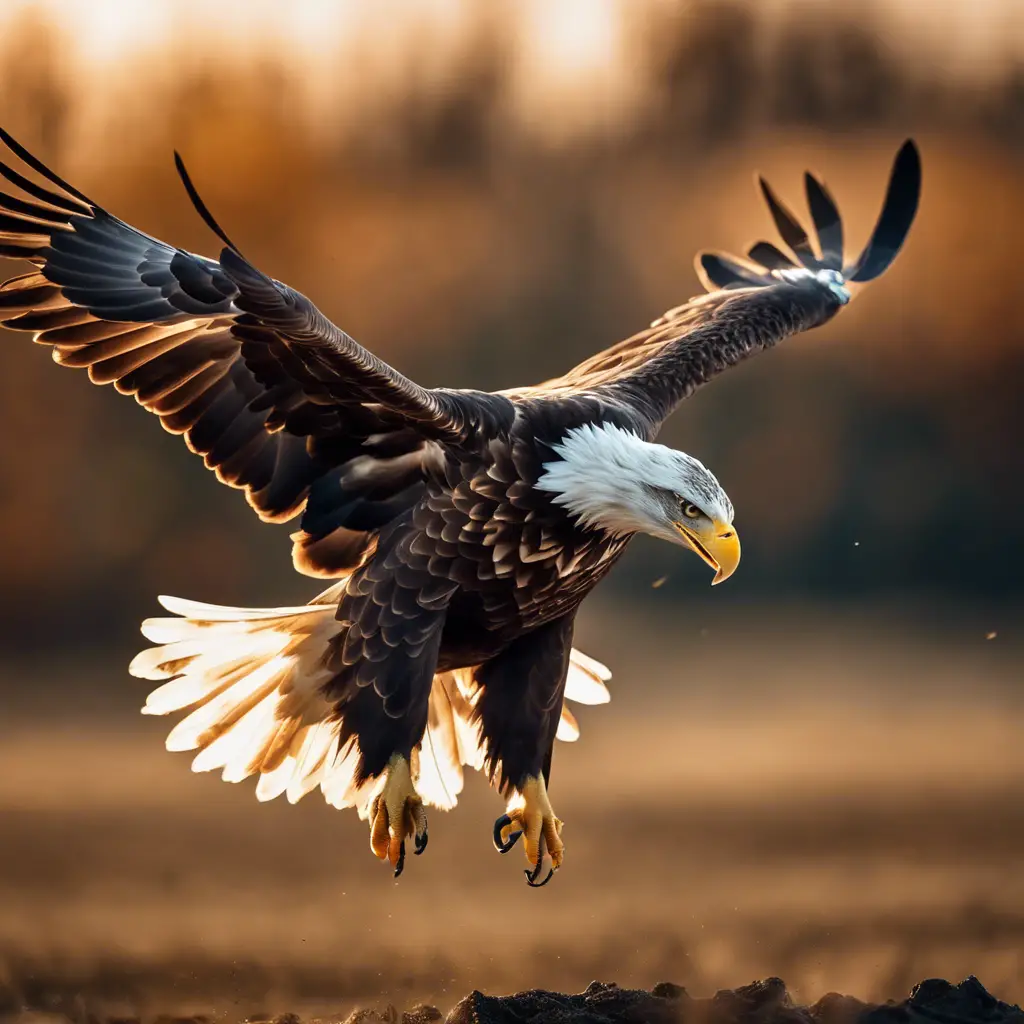Growing up in the shadow of the Rockies, my experience with eagles began early. As a young naturalist, I was captivated by the golden eagle’s aerial prowess, which later fueled my expertise in avian biology. I believe their flight is poetry in motion, a blend of raw power and grace.
Once, while tracking their migration, a golden eagle swept overhead at nearly 30 mph. I marveled at its control and speed, a testament to the years of study I’ve devoted to these raptors. Their survival, hinged on such capabilities, continues to inspire my research and admiration.
Key Takeaways
- The average speed of a Golden Eagle in level flight is 60 mph, while it can reach up to 200 mph in diving attacks.
- Golden Eagles are the second fastest birds, after falcons.
- Their broad and long wings, along with their powerful muscles, enable them to cover great distances and carry heavy loads.
- Factors such as wind resistance, altitude, physical condition, visual acuity, and experience can influence an eagle’s flight speed.
Eagle Species Velocity Profiles

Golden eagles boast remarkable speeds, averaging 60 mph in level flight and reaching up to 200 mph in diving attacks, outpacing all terrestrial animals and ranking them as the second fastest birds after falcons.
In normal flight, the golden eagle can reach cruising speeds between 28 and 32 mph. These eagle species velocity profiles demonstrate their ability to sustain impressive speeds of 150 to 200 mph, thanks to their aerodynamic bodies and expansive wingspans.
When considering how fast golden eagles can fly, it’s evident they’ve evolved for velocity, covering vast distances—up to 250 miles during migration days.
Their hunting strategy often involves diving at speeds that ensure they surprise and overpower slower-moving prey like goats and deer.
Wing Structure and Aerodynamics

Examining an eagle’s wing structure reveals a sophisticated blend of broad and lengthy wings that ensure both stability and agility in flight. As large birds of prey, eagles are capable of impressive feats thanks to their wing structure and aerodynamics. They can soar effortlessly, using rising air currents to gain altitude with minimal energy expenditure.
- Broad Wings: Spanning wide, these wings act like efficient gliders to reduce drag and support soaring.
- Long Wings: Length aids in horizontal flight, providing lift and allowing eagles to cover great distances.
- Powerful Muscles: Enable rapid takeoff and the strength to carry heavy loads.
- Alulae: These small feathers adjust airflow and enhance maneuverability.
- Airfoil Shape: Optimizes the ability to soar, by smoothing airflow and increasing lift while minimizing resistance.
Factors Influencing Flight Speed

Several factors can markedly influence an eagle’s flight speed, including wind resistance, altitude, the bird’s age and physical condition, its energetic needs, and both visual acuity and environmental conditions.
Eagles, known for soaring high with incredible speeds, can fly at different velocities, often exceeding 30 miles per hour while gliding and reaching up to 100 miles per hour when diving for prey.
Wind resistance can affect their speed, especially when facing headwinds or leveraging tailwinds. At higher altitudes, thinner air demands more effort for maneuverability, impacting speeds.
An eagle’s prime physical condition enables it to catch prey efficiently, utilizing thermal updrafts and excellent eyesight.
Younger eagles, still honing their skills, may fly slower than their experienced elders, whose energy-efficient flight patterns are fine-tuned for optimal hunting.
Eagle Speeds in Action

While factors like wind resistance and altitude play a significant role in determining flight speed, it’s the golden eagle’s remarkable hunting dives that truly showcase their astonishing velocity, reaching up to 200 mph as they plummet towards their prey.
Now, imagine the eagle speeds in action:
- A golden eagle soaring gracefully at heights with a wide wingspan, surveying the terrain below without flapping their wings.
- The sudden tilt of an eagle’s body as it spots a target, transitioning from eagle flying to diving.
- A bald eagle’s powerful wingbeats propelling it forward, effortlessly gliding across the sky.
- The intense focus of a golden eagle’s eyes, locked onto a distant animal, moments before the chase.
- The breathtaking dive of an eagle, outpacing even the peregrine falcon, in a high-speed pursuit.
These birds embody aerial mastery, transforming the skies into their hunting grounds with unmatched speed and agility.
Frequently Asked Questions
How Fast Can a Bald Eagle Fly Mph?
You’d be impressed to know that a bald eagle can fly at speeds of up to 75 mph when in level flight, and can dive at speeds over 100 mph when hunting prey.
Can a Eagle Fly 200 Mph?
You’ve asked if an eagle can fly at 200 mph; indeed, golden eagles may reach such speeds during dives, making them among the fastest birds when swooping down on their prey.
How Fast Can a Sea Eagle Fly?
You’re likely curious about sea eagles’ speed: they typically cruise at 30 mph, but can reach speeds of 50 mph in flight, though not as fast as the golden eagle’s dive.
How Far Can an Eagle Fly in a Day?
You’d be amazed to know that an eagle can fly up to 100 miles daily, and during migration, it can extend that feat to over 250 miles. They’re truly built for long-distance travel.
Conclusion
In conclusion, you’ve learned that golden eagles are astonishingly fast, diving at speeds up to 200 mph.
Their wing structure and aerodynamics are key to their velocity, allowing them to soar at 28 to 32 mph and cover vast distances.
Various factors, such as wind and prey pursuit, influence their speed.
Witnessing an eagle’s speed in action is to observe one of nature’s most impressive feats, showcasing the pinnacle of avian design and capability.

An avid ornithologist, zoologist and biologist with an unwavering passion for birds and wild animals.
Dr. Wilson’s journey in ornithology began in childhood and led him to obtain a Ph.D. in Ornithology from the prestigious Avian Research Institute. He has worked closely with renowned experts in the field and conducted extensive research and field studies globally.



